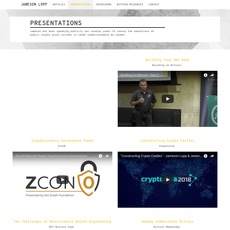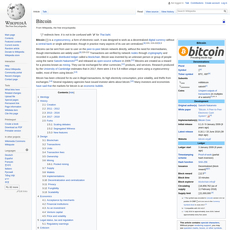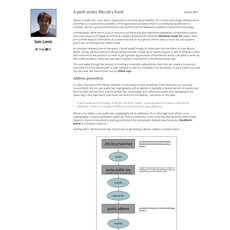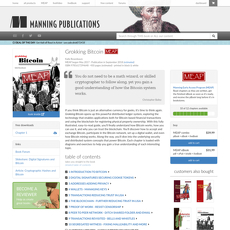Why Blockchain Programming and not Bitcoin Programming? Review
Why Blockchain Programming and not Bitcoin Programming?
programmingblockchain.gitbooks.io
Why Blockchain Programming (Not Just Bitcoin Programming)? A No-BS Review Guide + FAQ
Should you learn “blockchain programming” or go all-in on “Bitcoin programming”? It’s not a small choice. It affects the tools you pick, the projects you build, and the kind of work you’ll get paid to do.
Here’s the payoff: when you think in “blockchain programming,” you pick up skills that transfer across Bitcoin, Lightning, Ethereum, and newer chains. You avoid niche traps, learn the core primitives once, and stay useful as the ecosystem shifts.
TL;DR: Learn primitives once. Reuse them everywhere.
The fork in your path: Bitcoin-only or blockchain‑general?
You’re probably seeing conflicting advice:
- “Go Bitcoin-only.” It’s the most secure and battle-tested chain. True—and the tooling and constraints teach good engineering habits.
- “Go multi-chain.” The job market is broad, smart contracts are everywhere, and new L2s pop up monthly. Also true—if you can filter signal from hype.
Meanwhile, tutorials toss buzzwords at you, and half of them don’t connect to real-world projects. You want skills that won’t be obsolete by next year, but you don’t want to spend months on theory with nothing to show.
You’re not alone. Data shows developers move across ecosystems all the time: the Electric Capital Developer Report repeatedly finds that a significant chunk of active open-source crypto devs contribute across multiple repos and chains. Translation: portability wins.
Here’s my promise
I’ll keep this simple and practical. I’m going to show you why a blockchain-first mindset makes you a stronger builder—even if you later specialize in Bitcoin or the EVM. I’ll point you to one must-read resource that actually teaches fundamentals, and I’ll map out what to learn so you can build your first wallet, parser, or smart contract without spinning in circles.
What you’ll walk away with
- Clarity on scope: what “blockchain programming” covers vs. “Bitcoin programming.”
- A mental model: blocks, transactions, keys, signatures, scripts/VMs, and how they fit together.
- A lean plan: what to learn first, which language fits your goals, and what to build in weeks—not months.
- Confidence: you’ll see how to validate a block header, craft a testnet transaction, and ship something people can use.
Why this mindset keeps paying you
Chains change, primitives don’t. Hashes, keys, signatures, Merkle trees, transaction formats, fee logic, and consensus rules are the backbone everywhere. When you own those, switching from Bitcoin UTXOs to EVM accounts is a translation task—not a full reset.
Real example flow you’ll reuse:
- Wallet logic: seed phrases, derivation paths, xpubs—useful in Bitcoin and most EVM wallets.
- Transaction building: inputs/outputs and scripts in Bitcoin; calldata and gas in EVM—same discipline, different shapes.
- Validation mindset: parse headers, verify proofs, check policies—applies from Bitcoin nodes to rollup clients.
The one resource I’ll lean on
Programming Blockchain is a classic that teaches primitives first, then shows how Bitcoin fits them. It’s opinionated in a good way: less fluff, more first principles. Use it as the backbone while we add modern tooling and multi-chain context.
Who this is for
- New builders who want a straight path to a first wallet, parser, or simple contract.
- Bitcoin-curious devs who don’t want to get boxed into a niche.
- EVM folks who want stronger security instincts and transaction-level understanding.
- Analysts and data engineers who need to parse blocks/txs with confidence.
How we’ll keep it no‑BS
- Concrete wins: build on testnets, verify with multiple libraries, and ship small features.
- Tool-agnostic first: learn concepts, then pick the right stack for your goals.
- Security-conscious: “don’t roll your own crypto,” use PSBTs when possible, and test serialization/signing thoroughly.
Ready to make the choice that actually opens more doors? Next up, we’ll answer the exact question you’re probably asking: what’s the real difference between blockchain programming and Bitcoin programming—for a developer who wants to build real stuff?
Blockchain vs. Bitcoin: what’s the real difference for developers?
If you’ve been torn between “learning Bitcoin” and “learning blockchain,” here’s the short answer I wish someone told me earlier: Bitcoin is one network; blockchain programming is a reusable skillset. When you learn the core primitives once, you can build on Bitcoin, Lightning, Ethereum, Solana, Monero, and the next serious chain that pops up—without starting from zero.
Think in building blocks, not brand names. The fundamentals you’ll keep using:
- Hashing (SHA-256, Keccak) for IDs, commitments, and proofs
- Keys and signatures (secp256k1, Ed25519) for control and authorization
- Transactions (inputs/outputs or account nonces) for state changes
- Scripts/VMs (Bitcoin Script/Miniscript, EVM opcodes) for programmable rules
- Blocks and chains (headers, Merkle trees) for ordering and verification
- Consensus (PoW, PoS, fork choice) for who decides “the” history
- Networking (P2P, mempool, propagation) for getting your tx seen and mined
That list is the Swiss Army knife. Learn it once, then switch blades depending on the chain.
“We have proposed a system for electronic transactions without relying on trust.” — Satoshi Nakamoto, Bitcoin Whitepaper
Why this matters right now: developer activity isn’t locked to a single ecosystem. The latest Electric Capital Developer Report shows talent spread across many chains, with builders often shifting where the opportunity is. If you understand the primitives, you can move with the market without reinventing yourself every cycle.
Is blockchain the same as Bitcoin?
No. Bitcoin is the most battle-tested blockchain and the first to make the idea work at scale. But “blockchain” is the underlying data structure plus the rules for reaching agreement on it. In practice:
- Bitcoin = a specific blockchain with UTXOs, PoW, and Script.
- Blockchain = the general pattern: append-only ledger, cryptographic links, distributed consensus, and rules for how transactions update state.
Think of Bitcoin as an excellent “reference implementation” of blockchain ideas. Mastering it teaches you a lot—but it’s not the only place those ideas show up.
What is blockchain programming, in plain English?
It’s building software that can read, verify, create, and transmit data on a distributed ledger. On a day-to-day basis, that looks like:
- Key management: generate seeds, derive keys, store them safely, sign without leaking secrets
- Transaction building: collect inputs, set outputs, add scripts or call data, set fees/gas, serialize correctly
- Validation: parse blocks and headers, verify Merkle proofs, check signatures and scripts
- Mempool/fee logic: estimate fees, handle RBF/replace-by-fee or EIP-1559 tips, avoid stuck transactions
- P2P networking: talk to nodes, fetch mempool policies, broadcast, rebroadcast, and monitor confirmations
- Smart contracts (sometimes): write rules for a VM (Bitcoin Script/Miniscript, EVM, Move) that the network enforces
Here’s the practical “same-skill-different-chain” pattern I see in real projects:
- Keys/signatures: The secp256k1 skills you use to sign a Bitcoin PSBT help you sign an Ethereum transaction too—same curve, different serialization and fee model.
- Fees: Bitcoin uses sat/vB and mempool policy; Ethereum uses gas, a base fee, and a priority tip. Different knobs, same mental model: pay enough to be included without overpaying.
- Scripts/VMs: Learning Miniscript for time locks and multisig gives you a clean mental model of constraints. That transfers when you reason about EVM require() checks, re-entrancy guards, and access control.
- Proofs: Merkle proofs on Bitcoin, Merkle-Patricia tries on Ethereum—different structures, same job: verify inclusion efficiently without trusting a full node.
Do I need to learn Bitcoin first?
It helps—a lot. Bitcoin forces good habits: careful key handling, UTXO accounting, and tight security thinking. If you can build a correct, fee-efficient Bitcoin transaction, you’ve trained your brain to respect constraints. That discipline pays off everywhere else.
That said, don’t stop at one chain. The market rewards people who can read a block, reason about a mempool, and move funds safely—no matter the logo. I’ve seen teams ship faster because their engineers could switch from PSBT-based flows one week to EIP-1559 logic the next without “learning from scratch.”
Where Bitcoin-specific knowledge fits
- UTXO model: treat every coin as a discrete chunk you consume and create—great for parallelism and auditability.
- Script and Miniscript: compose spending conditions (multisig, time locks) with fewer footguns.
- PSBTs: standard way to coordinate signing between devices/services; useful in custody and wallets.
- Fee markets and mempool policy: understand RBF, CPFP, batching, and why some txs get ignored.
- Lightning: payment channels built on Bitcoin’s script and timelocks—teaches you state channels and penalty mechanisms.
Quick comparison to build intuition:
- UTXO (Bitcoin, Litecoin): spend “coins” by consuming outputs and creating new ones. Helps with privacy and parallel validation.
- Account model (Ethereum, many PoS chains): mutate account balances with nonces. It’s friendlier for smart contracts and rich state machines.
There’s a reason many security reviews start with fundamentals. Whether you’re parsing a Bitcoin block or auditing an EVM contract, the core checks—signatures valid, state transitions lawful, proofs sound—don’t change. That’s consistent with what we see in industry data: developers who grasp the primitives tend to navigate multi-chain work more easily, and the Electric Capital reports have tracked this multi-ecosystem movement for years.
I like to keep it human too. This space moves fast, and it’s easy to feel behind. Remember: tools and frameworks come and go, but a tight mental model of transactions, signatures, and validation is compounding knowledge. Learn it once, apply it for years.
Question for you: if you could bank one skill this month that pays off on any chain you touch next year, what would it be? In the next section, I’ll map out the exact primitives I’d master first—and how they future-proof your toolkit.
Why “blockchain programming” gives you a stronger long-term toolkit
I’ve seen tools, frameworks, and entire chains come and go. What doesn’t age is the set of primitives that every serious network relies on. When you learn blockchain programming (not just a single ecosystem), you build a toolkit that stays useful whether you’re writing a PSBT for Bitcoin, an EIP-1559 transaction for Ethereum, or parsing headers on a new L2.
Two reasons this approach wins long-term:
- Primitives don’t change with hype cycles: hashes, keys, signatures, Merkle trees, scripts/VMs, and consensus rules show up everywhere.
- Your skills travel: the same seed phrase and derivation logic that power a Bitcoin wallet also power an Ethereum wallet; the same serialization discipline helps you avoid signing the wrong bytes on any chain.
“If you can’t explain it simply, you don’t understand it well enough.” — often credited to Einstein. In crypto, that means: if you can’t explain a transaction, don’t ship one.
Security data backs this up. Year after year, the biggest losses come from basic failures—key compromise, bad nonce handling, and smart contract logic bugs—not from exotic math. Chainalysis and CertiK’s 2024 reports both highlight billions in exploit-driven losses, much of it preventable with stronger fundamentals. Learn the invariants first and you instantly become harder to hack and easier to hire.
Core ideas you should own before any chain-specific work
Here’s the short list I make every new engineer master. It’s not theory—these are the muscles you’ll flex daily.
- Wallets and key management
- Seed phrases (BIP39) and derivation paths (BIP32/SLIP-44). The same 12/24-word seed can deterministically derive keys for multiple chains:
- Bitcoin (native segwit):
m/84'/0'/0'/0/0 - Ethereum:
m/44'/60'/0'/0/0
One seed, many accounts—just don’t mix coin types by accident. - Bitcoin (native segwit):
- HSMs and hardware wallets: keep keys offline; sign carefully; never paste secrets into random libraries.
- PSBT flows (BIP174) for Bitcoin: safe multi-step signing you can adapt to custody and multi-sig setups.
- Seed phrases (BIP39) and derivation paths (BIP32/SLIP-44). The same 12/24-word seed can deterministically derive keys for multiple chains:
- Transactions
- Inputs/outputs and scripts (UTXO model) vs. account model with nonces (EVM). Different shapes, same goal: secure state transitions.
- Fees and cost accounting: sat/vB for Bitcoin; gas (price + limit) and EIP-1559 base/priority fees for Ethereum. Either way, you’re paying for blockspace.
- Serialization matters: witness vs. non-witness bytes in Bitcoin; RLP in Ethereum. If you don’t know exactly what you signed, assume you signed the wrong thing.
- Blocks and validation
- Headers, difficulty/target, timestamps, and versioning: you’ll parse these constantly.
- Merkle proofs: fast membership checks without downloading full data—useful across SPV light clients, bridges, and analytics.
- Consensus 101: PoW vs. PoS basics, finality assumptions, and reorg risk. If you don’t model finality, your app will eventually break.
- Networking
- P2P messages, mempool policy, and propagation. Bitcoin’s inv/getdata/tx rhythm vs. EVM gossip—different flavors, same latency/relay trade-offs.
- Why it matters: fee estimation, replacement (RBF / nonce bumps), and rebroadcast logic depend on mempool behavior.
- Security
- Threat modeling: keys, RPC endpoints, build pipelines, and dependency supply chain are common weak points.
- Signing flows: domain separation, typed data (EIP-712), PSBT fields—make intent explicit to the signer.
- Rule #1: don’t roll your own crypto. Use battle-tested libs, pin versions, and add test vectors.
Want a concrete taste of portability? Build a tiny HD wallet once, then output both a Bech32 Bitcoin address and an Ethereum checksummed address from the same seed. You’ll feel the “learn once, reuse everywhere” effect immediately.
Common mistakes beginners make
- Jumping straight into smart contracts without transaction basics
- Fix: first learn how a transaction is hashed, signed, and validated. Understand nonces, change outputs, and fee accounting.
- Copy-pasting code that “works” on testnet but ignores fee policy, nonce rules, or finality
- Fix: write parsers, not just cURL scripts. Validate transactions before broadcasting. Wait for meaningful confirmations/epochs.
- Chasing the newest chain every month
- Fix: pick one stack to practice fundamentals, then extend. The Electric Capital Developer Report shows developers with strong core skills transition chains more easily—and stick.
- Ignoring keys and wallets
- Fix: treat wallet logic like production cryptography. Use hardware signers, test PSBT or EIP-712 paths, and add signing simulations to CI.
When to go deep vs go broad
You don’t have to choose forever, but you should choose for now—based on the products you want to ship.
- Specialize in Bitcoin programming when:
- You’re building wallets, Lightning services, or settlement infrastructure.
- You work in custody, compliance-heavy fintech, or enterprise treasury.
- You care about UTXO policy, PSBT flows, Miniscript, watchtowers, or running hardened infrastructure.
- Go multi-chain when:
- You’re into dApps, DeFi protocols, cross-chain bridges, or analytics.
- You want security auditing work across EVM, Cosmos-SDK, Solana, and Bitcoin Script.
- You’re building SDKs or tools that abstract multiple chains behind one interface.
Either path still starts with the same foundations, because exploits don’t care what you “intended.” In 2024, hundreds of incidents across chains traced back to basics—reentrancy, access control errors, signature misuse, and key leaks. Read public post-mortems on Rekt or CertiK and you’ll see the same themes on repeat.
Here’s the emotional truth: it feels amazing to ship a contract or wallet fast, but it feels awful to explain a loss that a simple invariant would’ve prevented. Build your instincts around primitives and you’ll ship faster and safer.
Ready to turn this into a plan you can execute? Next up, I’ll show you the exact languages and tools I’d pick today—and a simple 8-week path to get from “reading” to “shipping.” Which stack do you think wins your week one: Python, TypeScript, Go, or Rust?
Languages, tools, and a no-fluff learning path
Confusion kills momentum. Clarity wins. You don’t need every language or every SDK; you need one solid stack, a few real tools, and a plan you can actually follow. The goal isn’t to collect buzzwords—it’s to ship code that signs, parses, validates, and moves value safely.
“Master the primitives, then pick the tools that make them boring.”
Two quick data points that match what I see in the trenches:
- Stack Overflow’s 2024 survey again shows Rust among the most loved languages, and Python remains a top choice for fast prototyping—both strengths matter for blockchain work.
- Electric Capital’s Developer Report highlights steady multi-chain developer activity, which is exactly why a portable toolkit pays off.
Which language is best for blockchain programming?
Pick one based on the kind of software you want to ship in the next 60 days. Here’s the no-spin breakdown with battle-tested libraries to get you moving.
- Python — fastest to prototype, perfect for parsing/analysis and scripting wallets
- Great for: block/tx parsers, wallet scripts, data pipelines, quick signing tools
- Bitcoin tooling: python-bitcoinlib, bip-utils
- EVM tooling: web3.py, Brownie
- Why choose it: you’ll iterate fast, write fewer lines, and learn the primitives without wrestling the compiler
- TypeScript/Node — the web wallet/dApp workhorse
- Great for: browser wallets, APIs, frontends that sign transactions, dApp backends
- Bitcoin tooling: bitcoinjs-lib, noble-secp256k1
- EVM tooling: ethers.js, viem, Hardhat, Foundry (with forge + anvil)
- Why choose it: instant fit for web3 UX, wallets, and API-driven apps
- Go — rock-solid for nodes, services, and concurrency
- Great for: light clients, indexers, microservices, and infra
- Bitcoin tooling: btcd/btcutil, Neutrino
- EVM tooling: go-ethereum (Geth), JSON-RPC clients
- Why choose it: easy concurrency model, stable binaries, production-friendly
- Rust — performance and safety for wallets, nodes, cryptography
- Great for: wallet backends, signing services, custom clients, cryptographic tooling
- Bitcoin tooling: rust-bitcoin, BDK
- EVM tooling: revm, Foundry
- Why choose it: safety without a GC, first-class crypto crates, predictable perf
- Solidity / Move — only if you are targeting those chains
- EVM: Solidity with Hardhat or Foundry
- Move: Aptos, Sui
- Why choose it: you need on-chain logic, audits, and protocol work in those ecosystems
Your 8-week, no-fluff roadmap
This is the shortest path I know from “curious” to “shipping.” Keep it strict. Don’t add tools unless a task forces you to.
- Week 1–2: Keys, signatures, hashing, addresses
- Generate a BIP39 mnemonic and derive child keys (BIP32/BIP44 or BIP84)
- Implement Base58Check and Bech32; verify against test vectors
- Sign and verify a message on secp256k1 with your chosen language’s crypto lib
- Outcome: a tiny CLI that creates keys, prints addresses, and verifies signatures
- Week 3–4: Parse blocks/transactions and broadcast on testnet
- Spin up a node or use a public API:
- Bitcoin: Bitcoin Core RPC (signet/testnet), or mempool.space API
- EVM: Geth/Nethermind + JSON-RPC
- Write a parser that reads block headers and transactions, and saves to CSV/SQLite
- Craft and broadcast one testnet transaction; programmatically confirm it
- Outcome: you can read raw data, build raw tx, and see it confirm on-chain
- Spin up a node or use a public API:
- Week 5–6: Fees, PSBT/gas, wallet logic
- Bitcoin:
- Use PSBT (BIP174) end to end (construct, sign, finalize)
- Fee estimation via your node’s estimatesmartfee and a mempool API fallback
- Add change output logic and RBF/CPFP where it makes sense
- EVM:
- Estimate gas and maxFeePerGas; handle nonces and replacement rules
- Sign and send a contract call; verify state change
- Outcome: a simple wallet engine that doesn’t lose money to fee mistakes
- Bitcoin:
- Week 7–8: Pick a lane and ship a small, real project
- Bitcoin path: Script/Miniscript spend policy, watch-only xpub wallet, or a fee bumping service
- EVM path: a minimal escrow or permit-based allowance tool with a clean CLI
- Outcome: a portfolio-ready repo with tests, README, and a short demo video
Tools I’d learn once and reuse everywhere
- Nodes and clients
- Bitcoin: Bitcoin Core (signet/testnet/regtest), btcd
- EVM: Geth, Nethermind, Anvil
- Wallet and signing
- Bitcoin: BDK, rust-bitcoin, HWI for hardware
- EVM: ethers.js/viem, HD wallet libs, Ledger/Trezor SDKs
- Build/test frameworks
- Bitcoin: regtest, functional tests, PSBT tooling
- EVM: Hardhat, Foundry, local nodes
- Explorers and APIs
- Bitcoin: mempool.space, Esplora
- EVM: any reliable JSON-RPC endpoint plus Etherscan-like APIs for indexing
Testing that actually catches bugs
If your tests don’t fail, they’re not testing. Focus on serialization, signing, and edge cases. That’s where real money gets lost.
- Local chains
- Bitcoin: regtest for instant blocks, signet for public but low-risk testing
- EVM: Hardhat Network or Anvil for fast forks and controlled state
- Unit tests around binary formats
- Assert exact bytes for tx serialization; use official test vectors where possible
- Check fee calculation down to the sat/wei after RBF or replacement
- Fuzzing
- Rust: cargo-fuzz for parsers and decoders
- EVM: Foundry’s fuzz tests; property-based tests on invariants (balances don’t go negative, nonces strictly increase)
- Integration checks
- Broadcast on testnet, then re-parse your own tx from the network and verify signatures and amounts before marking it “sent”
- For contracts: simulate calls locally, then confirm the exact state diff on a fork
Quick selector: choose your stack in 30 seconds
- If you want to build wallets and backend services: Rust or Go
- If you want data tooling or quick prototypes: Python
- If you want web wallets and dApps: TypeScript + ethers.js/viem
- If you need on-chain logic on EVM/Move: Solidity or Move (with Hardhat/Foundry or Aptos/Sui toolchains)
I’ll make it even simpler: pick one language, one node, and one testnet. Set a timer for 8 weeks and stick to the roadmap. Want to see how those weeks turn into a real transaction, a watch-only wallet, and your first on-chain tool—step by step, with exact tasks to build? That’s coming next. Ready to ship your first testnet transaction the right way?
Hands‑on guide: projects that force real understanding
Nothing sticks like shipping. Project‑based learning consistently outperforms passive reading in retention and transfer of skills—software engineering education studies find that building artifacts forces you to encode core concepts and retrieve them later with less friction. So here’s my no‑theory, all‑signal plan: five compact projects that give you real blockchain programming muscles while producing portfolio‑ready proof you can do the work.
Project 1: Create and sign a Bitcoin testnet transaction — then verify it twice
Why this matters: Transactions are the unit of work on almost every chain. If you can build, sign, and sanity‑check one end‑to‑end, you understand UTXOs, fees, and signatures—not just syntax.
- Setup
- Generate a seed (BIP39) and derive a testnet bech32 address on path m/84'/1'/0'/0/0.
- Fund it using a public testnet faucet.
- Build the transaction
- Fetch an unspent output (txid, vout, amount).
- Create a PSBT with one input and 2 outputs: recipient + change back to your wallet.
- Choose a fee rate (sat/vB) based on recent blocks; target 1–3 blocks for confirmation.
- Sign the PSBT with your private key and finalize it.
- Broadcast and verify with two independent tools
- Broadcast on testnet (your node’s RPC or a public endpoint).
- Verification #1: decode the raw tx and validate signatures via one library or node RPC.
- Verification #2: parse the same tx with a second library (different stack) and verify inputs, scripts, and fee math match your intent.
Acceptance checklist: your tx confirms in the targeted window; both tools agree on inputs, outputs, fee, and signature validity.
Common gotchas: change output missing (you accidentally overpaid fees), wrong HRP for testnet bech32, forgetting to set sequence for replace‑by‑fee, or mis‑estimating size.
Stretch goals: make it RBF‑capable; build a timelocked output (CSV/CLTV); or wrap spending policy in Miniscript to see how intent maps to Script.
Cross‑chain mapping: on EVM, this maps to building a raw transaction with nonce, gas limit, maxFeePerGas/maxPriorityFeePerGas, and verifying the signature and sender via two libraries.
Project 2: Block and transaction parser to CSV or a database
Why this matters: Parsing blocks/txs cements serialization, headers, Merkle trees, and how data flows across the network.
- What to build
- A small tool that streams blocks from height X to Y on testnet or mainnet (start small), extracts core fields, and writes them to CSV or SQLite/Postgres.
- Fields to store: block height, header hash, previous hash, timestamp, tx count; per‑tx: txid, input count, output count, total input, total output, fee, addresses (if applicable), scripts or method IDs (chain‑specific).
- Validation
- Verify block header hashes and link them (prevhash continuity).
- Recompute Merkle roots for a sampling of blocks; confirm equality.
- Handle reorgs: if a different block arrives at height H, reconcile your DB.
Common gotchas: endianness on txids and hashes, varint parsing, witness vs non‑witness serialization, and address derivation from scripts (Scriptpubkey parsing is not the same as “an address”).
Stretch goals: add a Merkle proof endpoint; export a list of the top N addresses by received value (heuristic); or compute a rolling fee histogram per block.
Cross‑chain mapping: for EVM chains, parse receipts and logs; export topics, addresses, and method selectors to analyze contract activity.
Project 3: Watch‑only wallet with xpubs
Why this matters: Real wallets are mostly about state, derivation, and correctness. A watch‑only wallet forces you to handle gap limits, descriptors, and tracking without risking keys.
- What to build
- Import a BIP32 xpub and derive external and change branches (e.g., m/84'/0'/0'/0/* and m/84'/0'/0'/1/*).
- Scan addresses forward with a gap limit (start with 20) until you hit consecutive unused slots, and record balances/UTXOs.
- Expose: balance summary, list of used addresses, and an export of unsigned PSBTs ready for an offline signer.
- Validation
- Confirm your derived addresses match what another wallet shows for the same xpub.
- Ensure change outputs are recognized and attributed correctly.
- Persist the last used index to avoid rescanning everything on startup.
Common gotchas: mixing mainnet/testnet version bytes for xpubs, off‑by‑one in derivation indexes, ignoring the change branch, and missing descriptor context (e.g., wpkh(xpub/…) vs sh(wpkh(…))).
Stretch goals: support output descriptors; add Miniscript policy descriptors; integrate an air‑gapped signing step and round‑trip PSBT finalization.
Cross‑chain mapping: the concept maps to EVM “watch wallet” tracking by public address set, plus label/index management and nonce tracking.
Project 4: Fee estimator and rebroadcast logic
Why this matters: Fees and mempool policy are where many “it worked on my laptop” projects fail in the wild. You’ll learn propagation, replaceability, and confirmation targets.
- What to build
- Collect mempool data: build a simple fee histogram by vbyte buckets over the last N minutes.
- Set a target (e.g., confirm within 1–3 blocks) and choose a sat/vB that clears the current queue.
- Construct transactions with RBF enabled; monitor their propagation and inclusion height.
- If stuck beyond your SLA, either:
- RBF: replace with a higher fee, or
- CPFP: spend the unconfirmed change output with a high‑fee child.
- Validation
- Log time‑to‑first‑seen, peers relayed to, and confirmation block.
- Prove your estimator beats a naïve fixed fee across volatile conditions over a week.
Common gotchas: forgetting to set the sequence for RBF, hitting ancestor/descendant limits, building CPFP that doesn’t pay enough to lift the package, and rebroadcasting too aggressively (some nodes throttle).
Cross‑chain mapping: on EVM chains, implement a gas price strategy using recent base fee, tip suggestions, and replacement rules; track pending txs and replacement via higher tips before inclusion.
Project 5 (EVM): Minimal escrow contract + interaction script
Why this matters: Smart contracts bring state machines and policy on‑chain. A minimal escrow shows how value flows, how to model roles, and how to test adverse paths.
- Contract scope
- Payer deposits funds.
- Arbiter approves release to payee or allows refund after timeout.
- Events: Deposited, Released, Refunded.
- Build and test
- Write a lean contract with checks‑effects‑interactions ordering and built‑in overflow checks (Solidity ≥0.8).
- Unit test: wrong caller reverts, double‑spend blocked, refund after time passes, events emitted as expected.
- Deploy on a public testnet and script interactions: deposit, approve, release, refund path.
- Verify event logs to confirm off‑chain monitoring works.
Security checklist: enforce role checks, ensure no reentrancy paths (guard or pull‑payment pattern), validate time logic, and avoid unsafe selfdestruct patterns.
Mapping back to Bitcoin: the same policy can be modeled with 2‑of‑2 multisig and a timelock (CLTV) for refunds—different tools, same primitives.
Pro tip: after each project, write a one‑page “what surprised me” note. Reflection turbo‑charges retention and lets you explain trade‑offs in interviews.
The one resource that makes these projects “click”
I always point beginners and cross‑trainers to Programming Blockchain (Jimmy Song). It teaches primitives first—hashes, keys, signatures, Merkle trees, Script—then shows how Bitcoin fits those primitives. That mental model transfers cleanly to other chains and tools.
How to use it for maximum ROI
- Read the intro chapters and implement each primitive in your language of choice: keygen, signing, transaction serialization, and Merkle proofs.
- After you pass the book’s examples, port one exercise to a different stack. Example: build a Merkle proof verifier for Ethereum receipts after you’ve coded one for Bitcoin blocks. You’ll feel the portability immediately.
- Cross‑verify your outputs with a second library or node RPC. If two independent tools agree with your implementation, you’re on the right track.
You’ve got the projects. You’ve got the resource. Next up, want quick answers to the questions I keep getting—“Is blockchain programming hard?”, “Do I need Bitcoin before Ethereum?”, “Which path pays better?”—I’ll tackle those head‑on in the FAQ that follows.
FAQ: quick answers I keep getting
Is blockchain programming hard?
It’s different, not impossible. You’ll use hashing, basic modular arithmetic, and digital signatures far more than heavy math proofs. The tough part is careful engineering: serialization details, signing flows, fee logic, and threat modeling.
Real example: the 2017 Parity multisig incident on Ethereum froze a huge amount of ETH because of a library/ownership mistake—great devs, tiny oversight, massive impact. The lesson isn’t “be scared,” it’s “treat state and permissions like live grenades.”
Another classic pitfall is bad randomness for ECDSA nonces. If you reuse or bias them, your private key can leak. This bit even hit early Android Bitcoin wallets years ago. Moral: use battle-tested libs and HSMs/secure enclaves where you can.
What’s the difference between a blockchain developer and a crypto developer?
- Blockchain developer: works on protocols, nodes, wallets, transaction builders, explorers, smart contracts, key management, P2P networking.
- Crypto developer: broader—exchanges, pricing feeds, analytics dashboards, custody flows, compliance tooling, payments, and apps that integrate crypto rails.
Plenty of folks wear both hats. If you want to be resilient across cycles, learn the protocol-level stuff and then layer product skills on top.
Do I need to learn Bitcoin before Ethereum (or the other way around)?
Learn the primitives first (keys, signatures, transactions, blocks, verification), then pick a specialization. If you like strict constraints and security culture, start with Bitcoin and UTXOs. If you’re excited by programmable state machines, start with EVM and contracts. Either way, you’ll reuse the same mental model.
Practical combo I recommend: build a small Bitcoin testnet wallet that crafts a transaction, then write a tiny escrow contract on a local EVM chain and interact with it from a script. You’ll feel the UTXO vs. account-based difference—and the shared building blocks.
Which pays more or has better jobs?
Both have solid demand. Security-savvy engineers, wallet devs, protocol/infrastructure folks, and auditors sit at the top of the food chain in any market. If you want a data point on ecosystem health, look at developer retention and activity—reports like Electric Capital’s Developer Report track monthly active devs and long-term contributors across chains.
Comp varies by stage (startup vs. established), token exposure, and jurisdiction. Infra and custody companies tend to be steadier; pure DeFi and gaming can swing wider but sometimes offer upside. Focus on improving your threat modeling, testing, and review discipline—that’s what gets rewarded.
How long until I’m employable?
If you can dedicate focused time, 6–8 weeks is enough to ship portfolio pieces that matter:
- A testnet wallet that builds, signs (PSBT or equivalent), and broadcasts transactions with change and fee controls.
- A block/transaction parser that validates headers and exports structured data.
- One smart contract (or Miniscript/Script policy) with a thorough test suite and a script that interacts with it.
Put everything in public repos, write clear READMEs, and include threat models and test coverage. Hiring managers love that.
Do I need a CS degree?
No. It helps, but provable skill beats paper. What moves the needle:
- Clean repos with tests around serialization, signing, and edge cases.
- Security awareness: reentrancy tests, nonce handling, fee/mempool policy, access control.
- Hands-on puzzles: try Ethernaut for EVM security or Bitcoin Script exercises for UTXO logic.
What are the top mistakes beginners make?
- Writing contracts before understanding transactions, signatures, and finality.
- Copy-pasting code without knowing fee/nonce rules or mempool policy.
- Chasing every new chain instead of mastering fundamentals that transfer.
- Rolling their own crypto. Don’t. Use audited libraries and well-known patterns.
How do I avoid scams and bad advice while learning?
- Prefer primary sources: protocol specs, reference clients, and audited libraries.
- Read postmortems. They’re free lessons paid by someone else’s pain.
- Keep keys off tutorials and never test with real funds. Use testnets/regtest/local chains.
- When in doubt, slow down. “Too good to be true” usually is.
What should I read or follow to stay sharp without burning out?
- Bitcoin Optech for weekly engineering notes and proposals.
- EIPs and Ethereum Magicians for standards and design debates.
- Node client repos (Bitcoin Core, rust-bitcoin, btcd, Geth, Nethermind) to see real-world code and PR discussions.
- Security blogs from wallet/custody teams and auditing firms; they share actionable patterns.
What gear and setup should I use?
- OS: Linux or macOS tends to be smoother for node tooling and scripts.
- Have Docker installed; it saves hours running nodes locally.
- Use language-specific formatters/linters, plus a basic fuzzing setup for serializers.
- Encrypt disk, use a password manager, and keep secrets out of repos. Yes, even on private repos.
How do I show “security thinking” in my projects?
- Include a short threat model for each project. Spell out assets, attackers, and mitigations.
- Write tests for failure paths: invalid signatures, low fees/gas, malleated txids, reorgs, reentrancy attempts.
- Document key handling, including non-extractable keys if you use a secure enclave or HSM.
- Pin dependency versions and explain why you chose each library.
Any signs I’m ready to specialize?
- You can read a block header and explain each field without googling.
- You’ve built and broadcast multiple testnet transactions or contract calls, handled fees/gas correctly, and debugged at least one mempool or nonce issue.
- You can explain UTXO vs. account models and when each shines.
Pro tip: if your repo has a README with a clear architecture sketch, a threat model, and tests people can run in one command, you’re already ahead of most applicants.
Final thought
If you want staying power, think like a blockchain programmer. Bitcoin knowledge is a pillar, not a silo. Master the primitives, ship small projects that prove you understand safety and correctness, then specialize where it fits your goals. That’s how you build skills that won’t fade next cycle.













